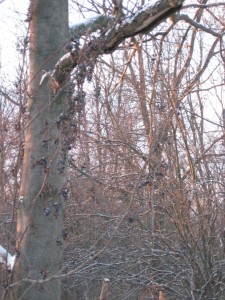There’s something shady about vines. Look at the names we give them—creepers, stranglers, parasites—they’re the bad guys of the plant world. To those of us raised in a strict Puritan work ethic, there’s something morally dubious about a plant that can’t stand on its own two feet, so to speak. Why can’t vines support themselves and not go draping themselves all over other plants?
A “clinging vine” is the very definition of weakness. But Darwin considered vines to be among the most powerful and highly-evolved plants on the planet. Vines like grapes, bittersweet and poison ivy are extremely successful plants, able to thrive in places where more upright, self-supporting types can’t. This is because vines, while remaining firmly rooted to the earth, can move in amazing ways that other plants haven’t mastered. They are, in fact, eerily non-plantlike, displaying an awareness of their surroundings and heading towards their goal with an almost human purposefulness.
Plants don’t have eyes, of course. But they have cells called photoreceptors on their leaves, which are stimulated by light. Vines actively seek light out, twisting and reaching ever higher till they find it. Like a hungry animal foraging for food, vines turn and grope over the forest floor, foraging for light.
Because to a plant, light is food. Photosynthesis is the name we give to the complex chain of chemical reactions that occurs in every green leaf: the miracle of turning air and water into sugars that nourish the plant. Sunlight is the start to this process, the key that turns the engine, so to speak. Most plants stay put and wait around until the ray of sun finds them. But vines go looking for excitement.
Wild grapes are wonderful food sources for wildlife, especially birds. The fruit is tart, tangy, ideal for jelly. But you can have too much of a good thing. Sometimes vines overwhelm their hapless hosts, and then you have to make a decision–grape vine or oak tree?





Recent Comments